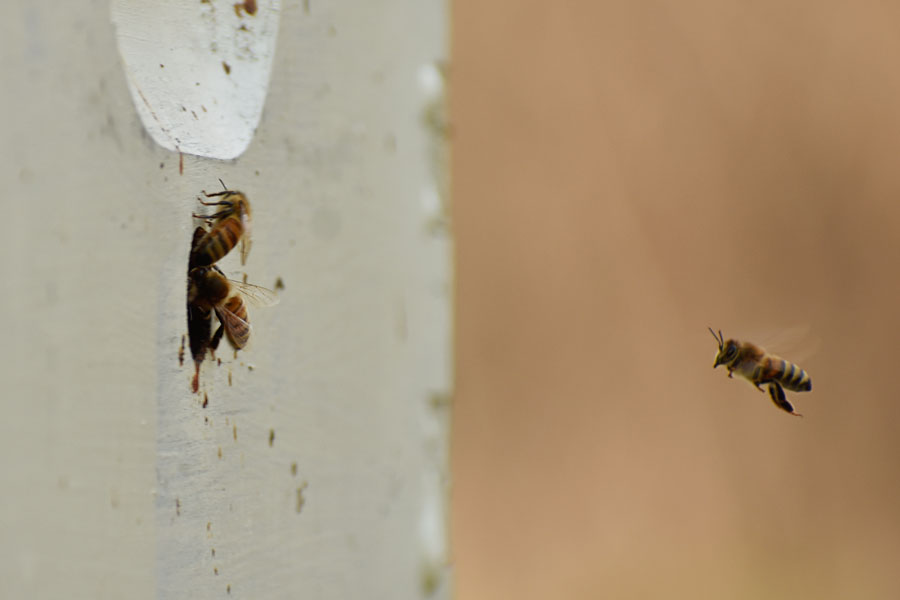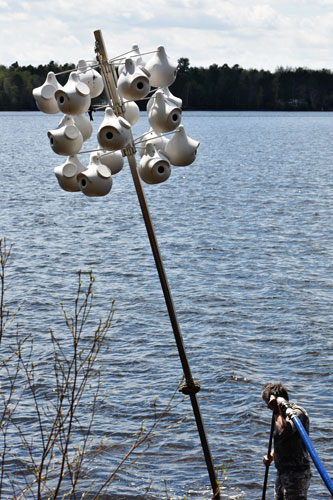I know that it is expected that I should grumble at an April snowfall…

… but instead I caught giant snowflakes on my tongue and smiled.
I know that it is expected that I should grumble at an April snowfall…

… but instead I caught giant snowflakes on my tongue and smiled.

Early in the winter I make my best guesses and place my orders for packages of bees. Those packages are two or three pound boxes of bees that will replace a hive that may (or may not) die out over the winter. After this is done I promptly forget how many packages I ordered and when I requested they arrive. This is key to my yearly process because that means when I get the call from the bee man that the bees have arrived, it’s always a fun spring surprise. Surprise! Drop everything, it’s time to hive the bees!
Now that sounds dramatic but here is a little secret. To hive the bees you take an empty beehive and you dump all the bees in the top. Then you put the lid on and leave.
The end.

Sure, it’s a little more nuanced than that. I usually take a few frames out so they have room to fall into the hive easier, the queen comes in her own special cage inside the package of bees and she needs to be placed in the hive within her little package first. And the art of slamming a two or three pound box of bees on the ground repeatedly and then shaking them out is… well, actually, that’s not much of an art. It’s just banging and shaking and it makes me feel like a mad woman every year. “Hey look, a few thousand bees in a box, lets bang them on the ground and dump them out!”
But, as beekeepers have known for ages bees without a hive to defend are really fairly docile. On a nice spring evening, the perfect time to hive a package of bees, many fly up in the air until you are inside a cloud of bees but they quickly locate their queen in the new hive and like magic settle back down inside. Before you know it the mad drama of shaking bees is over and you are free to put the lid on and leave.
Of course this year, as sometimes happens in April in Wisconsin, it was snowing. Making it a decidedly less idyllic situation. For starters it’s hard to wear a stocking cap under a bee veil without everything going cattywampus and falling over your eyes. In order to get them into the hive as quick as possible I upped my level of mad woman shaking and dumping and shaking and dumping, trying to get as many as possible inside, where they would soon warm it up before I put the lid on. All sorts of bees still filled the air but instead of finding the hive many of them found me and clung to me because it’s just too cold to fly in the snow when you are a little bee. A bunch of gentle flicking and swiping and plucking and shaking and finally the bees had been dumped on top of the hive, I put the lid on and walked away.
I’m participating in the April Squares challenge with The Life of B!
Sweet Pea the goose is laying eggs. While she is doing her best to keep the location secret we have been penning the geese in the yard for just that reason and we found her and her eggs deep in the gooseberry patch.

Perhaps once we make some delicious goose egg custard, a few giant omelettes and the next cold snap passes, we will let her try and hatch out a few of her own. Until then she’s going to have to try harder to keep the location secret!
I’m participating in the April Square hosted by The Life of B!
Thanks to online ordering and curbside pick up at our favorite local garden store I was able to dress up our window box. Now I can just see the pansies peeking through the window from inside.
Voila!
We supported a local business and added instant spring cheer to the place!

How are you finding spring cheer? Have you been able to support your local businesses?
I’m participating in the April Squares challenge over at The Life of B!
There are many signs of spring but when I look to the top of the maple trees and see that they are in bloom I feel secure that it’s really on it’s way.

The feeling probably stems from the relief of knowing that my bees (which did make it through the winter this year!) finally have a food source they can go out and forage.

If the bees can find food, it must really be spring.

I’m participating in the April Squares challenge over at The Life of B!
I loved my grandpa and he loved purple martins.
I shared his love purple martins too. These colony nesting birds make their homes in man-made houses on tall poles, eat on the wing and sing beautiful songs all day. And I could, and have, spent hours just watching them zoom in and out of their homes.
In the year after he passed away, I was explaining to John the necessity of me traveling three and a half hours north to our family’s cabin where the purple martin colony that Gramps spent years attracting, taking care of and recording their activity was.
John looked at me and said, “Alright, but you realize that you are being held hostage by your dead grandfather’s migratory birds, right?”
I laughed and went and took care of the martins.
 Last week I was standing thigh-deep in the lake in my underwear holding up the purple martin pole so that it’s three tiers of gourds and their precious cargo didn’t go crashing into the water with John’s words ringing in my ears. I could have laughed but my arms were too tired.
Last week I was standing thigh-deep in the lake in my underwear holding up the purple martin pole so that it’s three tiers of gourds and their precious cargo didn’t go crashing into the water with John’s words ringing in my ears. I could have laughed but my arms were too tired.
You see the cabin is on a flowage and on years that the water is high, the base of the martin pole is underwater. The martins don’t mind. In fact since they have eschewed the identical set up on land for many years in a row, I’d say they prefer it that way. Perhaps they just like to watch us squeal when we wade out to crank the whole colony down and check the nests when the water is cold and the wind is high.
In any case, one hazard of a pole being sunk into the water is that winter is often unkind to it, and by the time spring has come and the ice is gone, the pole develops a serious lean.
The preferred method of dealing with this lean is to run to the local hardware store and rent a trash pump. A trash pump being a fairly large pump that you can pump water and any other debris that might be floating by directly from the lake, through the pump, back out a four inch hose. Then, using a handy and ginormous wand my dad created, the water gets funneled to a one inch pipe and the resulting jet of water can be used to dig out the sand at the base of the pole. I was promised that “in less than five minutes” you can push it back to vertical.
It started out swimmingly. I, a novice to this project with only pants in my bag, was in charge of starting and stopping the pump as well as checking the status of the lean from dry land. My mom, in her experience and shorts, was in the water directing the jet and pushing the pole.
Then suddenly, with the help of a gust of wind, the pole started rapidly descending toward the water. Mom threw the wand down to grab the pole. I shut the pump off, threw my jeans in the grass and jumped into the water and before I knew it, there I was. Thigh deep in a northern Wisconsin flowage in May in my underwear with the words “you are being held hostage by your dead grandfather’s migratory birds” ringing in my ears.
Following that flurry of activity we had some minor issues with the pump that were eventually resolved, though it took a shovel, a canoe paddle, two wire stakes, a wooden bench that had floated to shore, approximately 37,000 hours of me or my mom standing holding a pole attached to a dozen gourds full of nests of Purple Martins, (did I mention they are cavity-nesting birds…basically dependent on man-made housing, just like what we were about to accidentally dump in the lake, for survival?) and a large amount of sheer stubbornness.
All the while as we pushed and schemed and figured how to get the pole upright, the martins swirled around us, calling to each other and even popped in and out of their chosen gourds. I guess it’s true. I am being held hostage by my dead grandfather’s migratory birds but I have to admit, I’m loving it, cold water and all.
I guess it’s true. I am being held hostage by my dead grandfather’s migratory birds but I have to admit, I’m loving it, cold water and all.
One April day the girl looked outside as the heavens opened wide and giant snowflakes filled the air. Large and wet they stuck to everything and turned the newly greened land white again. 
That night as the girl sat by her fire she pulled the first tick of the year off her dog, and thought to herself, “Spring is super weird.”